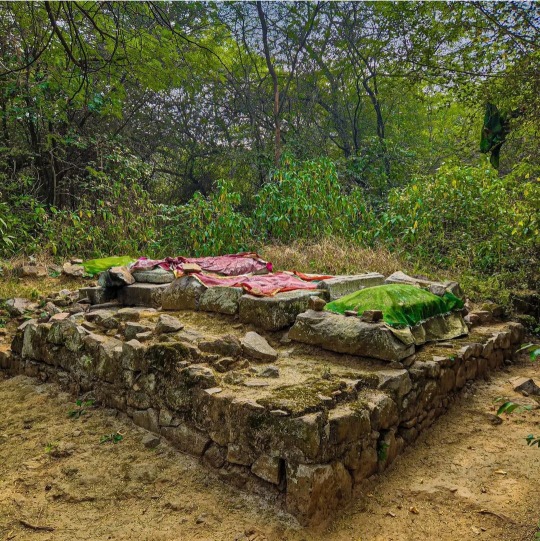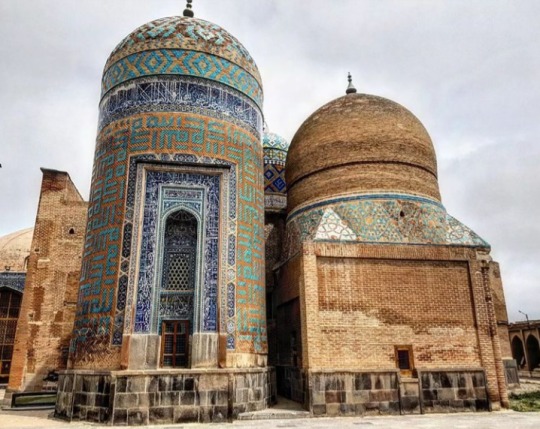#sufi
Text
There's something undeniably special about Kailash Kher's music, particularly the way he captures the essence of a woman's perspective in love. Listening to his songs feels like being truly seen and understood. The vulnerability, the intensity, the all-encompassing joy that comes with loving someone completely.
Thank you, Kailash Kher
You’re healing countless hearts:)
#kailash kher#teri deewani#desiblr#desi tag#desi tumblr#desi#sufi#sufi music#kailasa#bollywood songs#desi aesthetic#love#women in love#yearning
165 notes
·
View notes
Text


real ones remember
314 notes
·
View notes
Text



The oldest Sufi shrine in Delhi has been demolished.
"The earliest Sufi Shrine in Delhi - belonging to a relative of Prithviraj Chauhan and dating from BEFORE the Turkish conquest - has been Demolished by the Delhi Development Authority in an "anti encroachment" drive.
In the late 12th century, a group of Afghan pastoralists, suddenly burst onto the world stage. In a matter of years, they toppled their rulers of Ghazni and seized major Persian cities like Herat, and then established the major Indian sultanate in Delhi.
We often think of this "Islamic invasion" as the start of the Muslim presence in India. Yet recent scholarship has shown that by the time of Ghori's conquest of Delhi, Muslims were already a central part of Indian society
Some of the earliest mosques are found in Kerala, dating from a few decades after the prophet Muhammad's death. Tamil Pallava, Chola and Pandya kings all built sizeable mosques
Delhi also had a single sufi shrine before the Afghan conquest - this one.
Until 31 January, when it was demolished, the shrine of Baba Haji Rozbih had been located by the Fateh Burj, or Victory Gate of Lal Kot. The grave next to it under a reddish Chador belongs to his female disciple Bibi. Bibi was said to be a close relative of Prithviraj Chauhan who embraced Islam under the aegis of Haji Rozbih.
This demolition is an UTTERLY MINDLESS LOSS and complete cultural desecration.
What's more the "anti encroachment" drive is apparently scheduled to include the Aashiq Allah Dargah dated to 1317AD which is where the great Punjabi Saint Baba Farid used to meditate, and his small 'chillagah' is still visible here.
Please do share and write about this so we can save what remains! "
- from the historian Sam Dalrymple .
...
This is the third Islamic structure to be demolished in Delhi this month. Isn't it funny how only certain structures are the victim of anti- encroachment drives? This is part of a planned programme by the current right-wing government of India that is violently islamophobic and wants to create a hindu ethnostate modeled after Israel.
#india#desi tumblr#desiblr#south asia#punjab#sufi#sufism#islam#delhi#new delhi#anti-hindutva#anti-bjp#islamophobia#anti hindutva#anti bjp
138 notes
·
View notes
Text

In the 16th century in Punjab, Shah Hussain, a Sufi poet and mystic met and fell in love with a Hindu boy called named Madho Lal. Though gay marriage was not legal anywhere in the world before this century, Hussain and Madho defied social conventions and lived together for six years till Hussain's death in 1599. Hussain's poetry is significantly inspired by his relationship with Madho, with some poems addressed directly to him. After Hussain's death Madho continued to live close to where he was buried in present day Baghbanpura in Lahore, and was buried next to Hussain after his death. They continue to lie buried side by side in the same enclosure to this day, and the enclosure is named Hazrat Madho Lal Hussain, embodying one soul living in two bodies.
The annual celebration called Mela Chiraghan or Festival of Lights is held in March in Lahore in order to celebrate the love of Madho and Hussain as well as Hussain's poetry. It is unknown how the ritual was established, but it dates as far back as the the 18th century: there are records of Maharaja Ranjit Singh leading a barefooted procession from the Fort to the mausoleum for this celebration. At present, the festival is conducted over three days and attracts large crowds. Cotton-seed oil lamps are lighted in the streets and houses of the city. Devotees sing and dance and read Hussain's poetry in order to commemorate the triumph of tolerance over forces of bigotry.
#ots#gay history#lgbtq#lgbtqia#lgbt history#queer history#queer#mlm#punjab#sufi#lahore#pakistan#south asia#south asian#shah hussain#madho lal hussain#mela chiraghan#desi tumblr#desiblr#desi tag#south asian history
389 notes
·
View notes
Text
“I choose to love you in silence…
For in silence, I find no rejection,
I choose to love you in loneliness…
For in loneliness, no one owns you but me,
I choose to adore you from a distance…
For distance will shield me from pain,
I choose to kiss you in the wind…
For the wind is gentler than my lips,
I choose to hold you in my dreams…
For in my dreams, you have no end.”
― Rumi
#rumi#sufi#scholar#poet#dark academia#dark academia aesthetic#light academia#classic academia#classic literature#poetry#art academia#art#books#libraries#book quotes#literature quotes#deep quotes#life quotes#relatable quotes#bookblr#poetry quotes#lit
461 notes
·
View notes
Text
sufi cheating on anjali was not on my 2024 bingo card are you SERIOUSSSSS
84 notes
·
View notes
Text
Aşk defteri sığmaz dostlar dergahına,
Cümle aşk yığılıp bargahına..
Yedi cehennem dayanamaz bir ah'ına,
Her ne eylesen, Aşık eyle ALLAH'ım... ❤️
Ahmet Yesevi Hz.
204 notes
·
View notes
Text
I once had thousands of desires. But in my one desire to know You, all else melted away.
~Rumi
#rumi#sufism#sufi#sufi wisdom#sufi quotes#desi tumblr#just desi things#desi larki#desi academia#life of a desi girl#shams tabrizi#allah#islam#islamic
191 notes
·
View notes
Text
You did not have to search far for me, for I have been with you since the beginning. Look for my soul inside of yours.
A Rumi inspired piece I wrote back in 2017 when I was known as Honour Speaks on Instagram (I have since left Instagram several years ago.) I was heavily influenced by sufi style back then. Giving this piece new life. Dedicating it to a dear friend of mine.
Music by Cengiz Kurtoğlu.
#poets on tumblr#love quotes#love poetry#romantic poetry#love poem#romantic writer#poets and writers#onurtaskiran poetry#gentleman poet#love#spilled ink#rumi inspired#sufi#kan kardeşim#soul connection#soul friend#bond#poetry by onur#soulful#soul siblings
191 notes
·
View notes
Text
"Stay close to anything that makes you glad that you are alive."-Hafiz
#arabic#poetry#poem#hafiz of shiraz#rumi#rumi quotes#paulo coelho#love quotes#feeling#anais nin#sufi wisdom#sufi#sufi quotes#sufism#tao te ching#kundalini yoga#meditation
83 notes
·
View notes
Text

“Take my shirt and lay it over my father's face: he will recover his sight. Then bring your whole family back to me.”
Surah Yusuf verse 93.
In different eras and places among Muslims talismanic shirts were worn under the regular robes of people to offer protection from Nazar and Sihr. It is believed that this tradition dates back to the prophet Yusuf (Joseph). One of the more famous practitioners of this tradition are the Ottomans, sultans such as Cem Sultan and Süleyman-ı Evvel wore them. This Quran verse is what inspired this.
#books#history#literature#religion#theology#mysticism#esotericism#religious#orthodox#sufi#Sufism#ottomans#ottoman history#islam#islamic history#islamic theology#islamic tradition#traditionalism#traditional#sunni muslim#shia muslim#Muslims#shia#Sunni#haqq#hanafi#ahlulbayt#Middle East#orient#oriental art
68 notes
·
View notes
Text
66 notes
·
View notes
Text
عید گاہ ما غریباں کوئے تو، ایں بہ ساعت عید، دیدن روئے تو
“Your street is Eid-gaah for us poors, The glimpse of your face is the moment of Eid.”
— Amir Khusrau
#amir khusro#amirkhusrau#eidulfitr#eid mubarak#chaand#eid#eidfestival#muslimfestival#urdu#urdu lines#sufi wisdom#sufi poetry#sufism#sufi#aesthetic poetry#aesthetics#عید#چاند#moon#her face#pretty face#glory#urdu adab#urdu poetry#urdu stuff#fav#rekhta#desiblr#spilled truth#writer and poets
48 notes
·
View notes
Text

'I want both of Us' by Hafiz.
#poetry#poems#poets#hafiz#poetrylover#poet#dead poets society#dark academia#chaotic academia#academia#literature#sufi#light academia#reading#quotes#quote#romatic academia#read#books#books & libraries#aesthetic#life#art#love#love poems
81 notes
·
View notes
Text


Sheykh safi tomb/ Ardabil/ Iran
Photography: elham nazari
#iran#middle east#iranian#persian#persia#travel#farsi#art#culture#architecture#ardabil#sufi#persian architecture#persian art#tomb
887 notes
·
View notes
